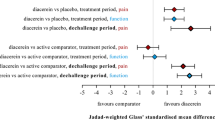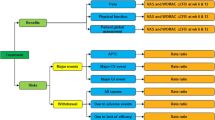Abstract
Osteoarthritis (OA) is the leading musculoskeletal cause of disability. Despite this, there is no consensus on the precise definition of OA and what is the best treatment to improve symptoms and slow disease progression. Current pharmacological treatments include analgesics, non-steroidal anti-inflammatory drugs (NSAIDs) and cyclooxygenase (COX) inhibitors. None of those treatments are disease-modifying agents that target the core pathological processes in OA. Diacerein, a semi-synthetic anthraquinone derivative, inhibits the interleukin-1-beta (IL-1β) cytokine which, according to animal studies, plays a key role in the pathogenesis of OA. Diacerein was synthesized in 1980 and licensed in some European Union and Asian countries for up to 20 years. It has shown modest efficacy and acceptable tolerability in a number of trials of low to moderate quality. Early this year, the European Medicines Agency (EMA) conducted a review and restricted the use of diacerein-containing medicines. This was because of major concerns about the frequency and severity of diarrhoea and liver disorders in OA patients. In addition, the EMA’s Pharmacovigilance Risk Assessment Committee (PRAC) questioned the limited clinical benefits of diacerein, which, in their view, did not outweigh its risks. The aim of this review is to provide a benefit–risk assessment of diacerein in the treatment of OA, based on asystematic evaluation of the published efficacy and safety data. Overall, there is evidence that diacerein is modestly effective for symptoms and possibly for radiographic changes, but this needs to be balanced against higher rates of gastrointestinal toxicity.

Similar content being viewed by others
References
Jones G. Sources of pain in osteoarthritis: implications for therapy. Int J Clin Rheumatol. 2013;8:335–46.
Fidelix TS, Macedo CR, Maxwell LJ, Fernandes Moça Trevisani V. Diacerein for osteoarthritis. Cochrane Database Syst Rev. 2014;2:CD005117.
Zhang W, Nuki G, Moskowitz RW, et al. OARSI recommendations for the management of hip and knee osteoarthritis: part III. Changes in evidence following systematic cumulative update of research published through January 2009. Osteoarthritis Cartilage. 2010;18:476–99.
Louthrenoo W, Nilganuwong S, Aksaranugraha S, Asavatanabodee P, Saengnipanthkul S, Thai Study Group. The efficacy, safety and carry-over effect of diacerein in the treatment of painful knee osteoarthritis: a randomised, double-blind, NSAID-controlled study. Osteoarthritis Cartilage. 2007;15(6):605–14.
Pavelka K, Trc T, Karpas K, Vítek P, Sedlácková M, Vlasáková V, Böhmová J, Rovenský J. The efficacy and safety of diacerein in the treatment of painful osteoarthritis of the knee: a randomized, multicenter, double-blind, placebo-controlled study with primary end points at two months after the end of a three-month treatment period. Arthritis Rheum. 2007;56(12):4055–64.
Kirkham B. Interleukin-1, immune activation pathways, and different mechanisms in osteoarthritis and rheumatoid arthritis. Ann Rheum Dis. 1991;50:395–400.
Stannus O, Jones G, Cicuttini F, et al. Circulating levels of IL-6 and TNF-α are associated with knee radiographic osteoarthritis and knee cartilage loss in older adults. Osteoarthritis Cartilage. 2010;18:1441–8.
Pelletier JP, Yaron M, Haraoui B, et al. Efficacy and safety of diacerein in osteoarthritis of knee: a double-blind, placebo controlled trial. The Diacerein Study Group. Arthritis Rheum. 2000;43(10):2339–48.
Dougados M, Nguyen M, Berdah L, et al. Evaluation of structure modifying effect of diacerein in hip osteoarthritis: ECHODIAH, a three-year, placebo-controlled trial evaluation of the chondromodulating effect of diacerein in osteoarthritis of the hip. Arthritis Rheum. 2001;44(11):2539–47.
Lane NE, Brandt K, Hawker G, et al. OARSI–FDA initiative: defining the disease state of osteoarthritis. Osteoarthritis Cartilage. 2011;19:478–82.
Spencer CM, Wilde MI. Diacerein. Drugs. 1997;53(1):98–106.
Pham T, Le Henanff A, Ravaud P, Dieppe P, Paolozzi L, Dougados M. Evaluation of the symptomatic and structural efficacy of a new hyaluronic acid compound, NRD101, in comparison with diacerein and placebo in a 1 year randomised controlled study in symptomatic knee osteoarthritis. Ann Rheum Dis. 2004;63(12):1611–7.
Acknowledgments
No sources of funding were used in the preparation of this review. Elena Panova and Graeme Jones have no conflicts of interest that are directly relevant to the content of the review.
Author information
Authors and Affiliations
Corresponding author
Rights and permissions
About this article
Cite this article
Panova, E., Jones, G. Benefit–Risk Assessment of Diacerein in the Treatment of Osteoarthritis. Drug Saf 38, 245–252 (2015). https://doi.org/10.1007/s40264-015-0266-z
Published:
Issue Date:
DOI: https://doi.org/10.1007/s40264-015-0266-z




